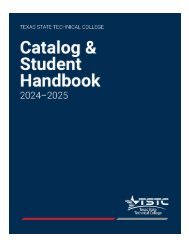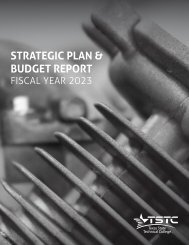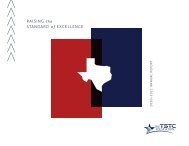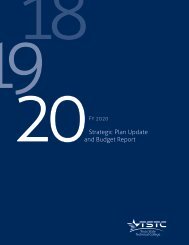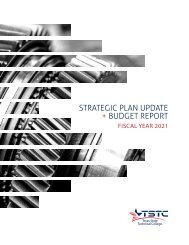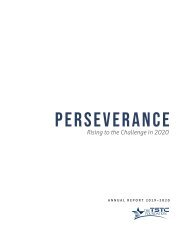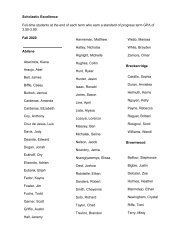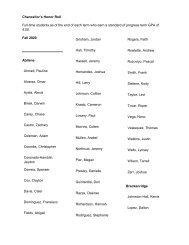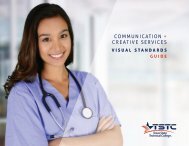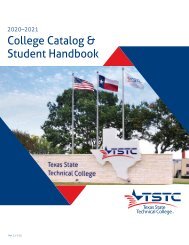Student Handbook and Catalog 2021-22 V2
Create successful ePaper yourself
Turn your PDF publications into a flip-book with our unique Google optimized e-Paper software.
Course Descriptions | 177<br />
BIOL 1313 (3-0-3) Fundamental biological concepts relevant to<br />
animals, including systematics, evolution, structure <strong>and</strong> function,<br />
cellular <strong>and</strong> molecular metabolism, reproduction, development,<br />
diversity, phylogeny, <strong>and</strong> ecology. (This course is intended<br />
for science majors.) Prerequisite: MATH 1314 or MATH 1414<br />
Recommended prerequisite<br />
BIOL 13<strong>22</strong> (3-0-3) This course introduces general nutritional<br />
concepts in health <strong>and</strong> disease <strong>and</strong> includes practical applications<br />
of that knowledge. Special emphasis is given to nutrients <strong>and</strong><br />
nutritional processes including functions, food sources, digestion,<br />
absorption, <strong>and</strong> metabolism. Food safety, availability, <strong>and</strong> nutritional<br />
information including food labels, advertising, <strong>and</strong> nationally<br />
established guidelines are addressed.<br />
BIOL 1406 (3-3-4) This lecture <strong>and</strong> lab course should combine all of<br />
the elements of BIOL 1306 Biology for Science Majors I (lecture) <strong>and</strong><br />
BIOL 1106 Biology for Science Majors I (lab), including the learning<br />
outcomes listed for both courses.<br />
BIOL 1407 (3-3-4) This lecture <strong>and</strong> lab course should combine all<br />
of the elements of BIOL 1307 Biology for Science Majors II (lecture)<br />
<strong>and</strong> BIOL 1107 Biology for Science Majors II (lab), including the<br />
learning outcomes listed for both courses.<br />
BIOL 1408 (3-3-4) This lecture <strong>and</strong> lab course should combine<br />
all of the elements of BIOL 1308 Biology for Non-Science Majors<br />
I (lecture) <strong>and</strong> BIOL 1108 Biology for Non- Science Majors I (lab),<br />
including the learning outcomes listed for both courses.<br />
BIOL 1409 (3-3-4) This lecture <strong>and</strong> lab course should combine all<br />
of the elements of BIOL 1309 Biology for Non-Science Majors II<br />
(lecture) <strong>and</strong> BIOL 1109 Biology for Non-Science Majors II (lab),<br />
including the learning outcomes listed for both courses.<br />
BIOL 1411 (3-3-4) This lecture <strong>and</strong> lab course should combine all of<br />
the elements of BIOL 1311 (lecture) <strong>and</strong> BIOL 1111 (lab), including<br />
the learning outcomes listed for both courses.<br />
BIOL 2101 (0-3-1) The lab provides a h<strong>and</strong>s-on learning experience<br />
for exploration of human system components <strong>and</strong> basic physiology.<br />
Systems to be studied include integumentary, skeletal, muscular,<br />
nervous, <strong>and</strong> special senses.<br />
BIOL 2102 (0-3-1) The lab provides a h<strong>and</strong>s-on learning experience<br />
for exploration of human system components <strong>and</strong> basic physiology.<br />
Systems to be studied include endocrine, cardiovascular, immune,<br />
lymphatic, respiratory, digestive (including nutrition), urinary<br />
(including fluid <strong>and</strong> electrolyte balance), <strong>and</strong> reproductive (including<br />
human development <strong>and</strong> genetics).<br />
BIOL 2116 (0-3-1) Study of the principles of molecular <strong>and</strong> classical<br />
genetics <strong>and</strong> the function <strong>and</strong> transmission of hereditary material.<br />
May include population genetics <strong>and</strong> genetic engineering.<br />
BIOL 2120 (0-3-1) This course covers basics of culture <strong>and</strong><br />
identification of bacteria <strong>and</strong> microbial ecology. This course is<br />
primarily directed at pre-nursing <strong>and</strong> other pre-allied health<br />
majors <strong>and</strong> covers basics of microbiology. Emphasis is on medical<br />
microbiology, infectious diseases, <strong>and</strong> public health.<br />
BIOL 2121 (0-3-1) This laboratory-based course accompanies<br />
Biology 2321, Microbiology for Science Majors. Laboratory activities<br />
will reinforce principles of microbiology, including metabolism,<br />
structure, function, genetics, <strong>and</strong> phylogeny of microbes. The course<br />
will also examine the interactions of microbes with each other,<br />
hosts, <strong>and</strong> the environment. Prerequisite: BIOL 2321 (Prerequisite or<br />
Corequisite)<br />
BIOL 2301 (3-0-3) Anatomy <strong>and</strong> Physiology I is the first part of a<br />
two course sequence. It is a study of the structure <strong>and</strong> function<br />
of the human body including cells, tissues <strong>and</strong> organs of the<br />
following systems: integumentary, skeletal, muscular, nervous <strong>and</strong><br />
special senses. Emphasis is on interrelationships among systems<br />
<strong>and</strong> regulation of physiological functions involved in maintaining<br />
homeostasis.<br />
BIOL 2302 (3-0-3) Anatomy <strong>and</strong> Physiology II is the second part of<br />
a two-course sequence. It is a study of the structure <strong>and</strong> function<br />
of the human body including the following systems: endocrine,<br />
cardiovascular, immune, lymphatic, respiratory, digestive (including<br />
nutrition), urinary including fluid <strong>and</strong> electrolyte balance), <strong>and</strong><br />
reproductive (including human development <strong>and</strong> genetics).<br />
Emphasis is on interrelationships among systems <strong>and</strong> regulation of<br />
physiological functions involved in maintaining homeostasis.<br />
BIOL 2316 (3-0-3) Study of the principles of molecular <strong>and</strong> classical<br />
genetics <strong>and</strong> the function <strong>and</strong> transmission of hereditary material.<br />
May include population genetics <strong>and</strong> genetic engineering.<br />
BIOL 2320 (3-0-3) This course covers basic microbiology <strong>and</strong><br />
immunology <strong>and</strong> is primarily directed at pre-nursing, pre-allied<br />
health, <strong>and</strong> non-science majors. It provides an introduction to<br />
historical concepts of the nature of microorganisms, microbial<br />
diversity, the importance of microorganisms <strong>and</strong> acellular agents in<br />
the biosphere, <strong>and</strong> their roles in human <strong>and</strong> animal diseases. Major<br />
topics include bacterial structure as well as growth, physiology,<br />
genetics, <strong>and</strong> biochemistry of microorganisms. Emphasis is on<br />
medical microbiology, infectious diseases, <strong>and</strong> public health.<br />
BIOL 2321 (3-0-3) Principles of microbiology, including metabolism,<br />
structure, function, genetics, <strong>and</strong> phylogeny of microbes. The course<br />
will also examine the interactions of microbes with each other,<br />
hosts, <strong>and</strong> the environment.<br />
BIOL 2401 (3-3-4) This lecture <strong>and</strong> lab course should combine all of<br />
the elements of BIOL 2301 Anatomy <strong>and</strong> Physiology I (lecture) <strong>and</strong><br />
BIOL 2101 Anatomy <strong>and</strong> Physiology I (lab), including the learning<br />
outcomes listed for both courses.<br />
BIOL 2402 (3-3-4) This lecture <strong>and</strong> lab course should combine all of<br />
the elements of BIOL 2302 Anatomy <strong>and</strong> Physiology II (lecture) <strong>and</strong><br />
BIOL 2102 Anatomy <strong>and</strong> Physiology II (lab), including the learning<br />
outcomes listed for both courses.<br />
BIOL 2404 (3-3-4) Study of the structure <strong>and</strong> function of<br />
human anatomy, including the neuroendocrine, integumentary,<br />
musculoskeletal, digestive, urinary, reproductive, respiratory,<br />
<strong>and</strong> circulatory systems. Content may be either integrated or<br />
specialized.<br />
Texas State Technical College<br />
tstc.edu



